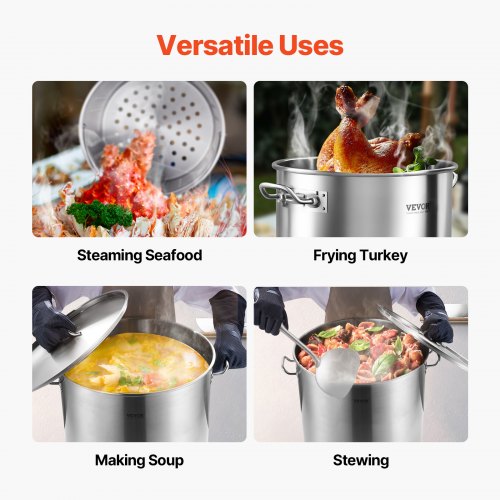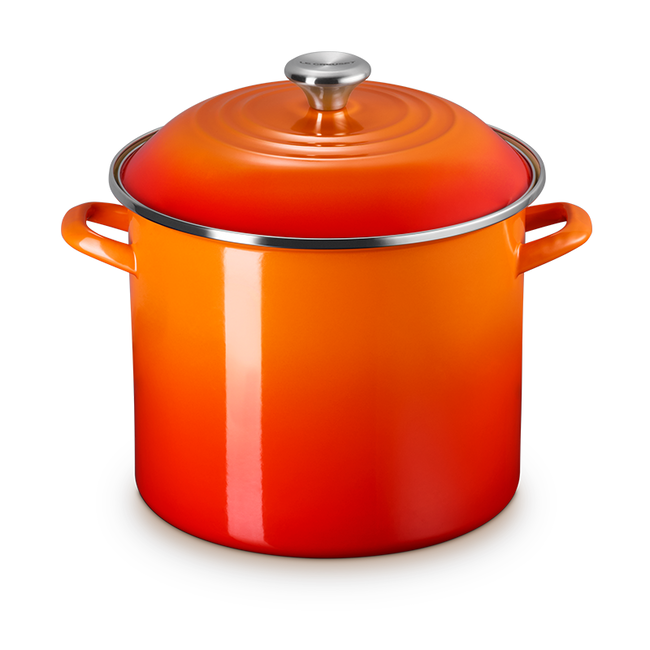Choosing the right stockpot can change the way you cook forever. Whether you’re simmering a hearty stew or boiling pasta for your family, having the perfect pot makes all the difference.
You might think all stockpots are the same, but the truth is, the right one saves you time, energy, and frustration. You’ll discover exactly what to look for so your kitchen feels more efficient and enjoyable. Keep reading, and you’ll never have to settle for a pot that doesn’t meet your needs again.

Credit: www.carawayhome.com
Material Types
Choosing the right stockpot material affects cooking results. Different materials offer unique benefits.
Understanding these materials helps you pick a pot that fits your kitchen needs.
Stainless Steel Benefits
Stainless steel is strong and lasts a long time. It does not rust or stain easily.
This material is good for cooking many types of food. It does not react with acidic ingredients.
Aluminum For Even Heating
Aluminum heats up quickly and spreads heat evenly. It helps food cook without hot spots.
Many pots use aluminum cores inside layers to improve cooking performance.
Copper For Precision Cooking
Copper conducts heat very well. It lets you control cooking temperature with accuracy.
Copper pots often have stainless steel linings to prevent reactions with food.
Nonstick Options
Nonstick pots need less oil and are easy to clean. They are good for cooking delicate foods.
Use nonstick stockpots with care to avoid scratching the surface.
Size Considerations
Choosing the right stockpot size is important for cooking success. The size you pick depends on your cooking needs and kitchen space.
A stockpot that fits your usual recipes helps save energy and keeps food tasting fresh. Let’s look at different sizes and their uses.
Small Stockpots For Everyday Use
Small stockpots usually hold 4 to 6 quarts. They are good for cooking soups, sauces, or boiling small amounts of pasta.
These pots heat quickly and use less energy. They fit well on small stoves and in limited kitchen spaces.
- Holds 4 to 6 quarts
- Great for soups and sauces
- Heats quickly
- Easy to store
Large Stockpots For Entertaining
Large stockpots hold 12 quarts or more. They are best for cooking big meals for family or guests.
Use these pots for making large batches of stew, boiling seafood, or preparing stock. They need more stove space and take longer to heat.
- Holds 12 quarts or more
- Perfect for big meals
- Good for stews and seafood
- Requires more stove space
Versatile Medium Sizes
Medium stockpots hold about 8 to 10 quarts. They balance size and ease of use well.
These pots work for both everyday cooking and occasional larger meals. They fit most stove tops and storage spaces.
- Holds 8 to 10 quarts
- Good for daily and larger meals
- Fits most stoves
- Easy to clean and store
Heat Distribution
Heat distribution is key when choosing a stockpot. It affects how evenly your food cooks. Poor heat spread can cause hot spots and burn your meal.
Understanding the factors that influence heat distribution helps you pick the right pot. Material, base thickness, and weight all play a role.
Impact Of Material On Heat
The material of the stockpot affects how fast and evenly heat spreads. Different materials conduct heat differently, which changes cooking results.
- Aluminum heats up quickly but can create hot spots.
- Stainless steel is durable but may heat unevenly without layers.
- Copper offers the best heat conduction but is costly.
- Cast iron holds heat well but heats slowly.
Base Thickness Importance
A thicker base helps spread heat evenly and avoids burning food. Thin bases heat fast but cause uneven cooking.
| Base Thickness | Effect on Heat |
| Thin (1-2 mm) | Quick heat, uneven cooking |
| Medium (3-4 mm) | Balanced heat, better control |
| Thick (5+ mm) | Slow heat, very even cooking |
Weight And Heat Retention
Heavier stockpots usually hold heat longer. This helps keep food warm and cook evenly. Lightweight pots cool down fast.
Consider these points about weight and heat retention:
- Heavy pots keep a steady temperature.
- Light pots may need constant heat adjustment.
- Weight affects how easy the pot is to handle.

Credit: www.vevor.ca
Lid Features
Choosing the right lid for your stockpot is important. The lid controls heat and moisture while cooking.
Different lids offer different benefits. Look at materials, ventilation, and handles when picking a lid.
Glass Vs. Metal Lids
Glass lids let you see inside without lifting them. This helps keep heat and steam in the pot.
Metal lids are very durable and fit tightly. They keep heat and moisture sealed well but you cannot see inside.
- Glass lids show cooking progress
- Metal lids hold heat better
- Glass lids can break if dropped
- Metal lids are more resistant to damage
Ventilation And Steam Release
Some lids have small holes or vents to let steam escape. This helps prevent boiling over.
Lids without vents trap steam inside. This keeps food moist but may cause pressure to build up.
- Vented lids reduce boil-overs
- Non-vented lids keep moisture in
- Choose vented lids for soups and stews
- Non-vented lids work well for slow cooking
Handles And Grip
Lid handles should be easy to hold and stay cool. This makes lifting the lid safer and easier.
Some handles are made of metal, others have silicone or plastic covers. Choose what feels best for you.
- Metal handles are durable but may get hot
- Silicone handles stay cool to touch
- Plastic handles offer a good grip
- Look for wide handles for better control
Ease Of Cleaning
Choosing a stockpot that cleans easily saves time in the kitchen. Understanding cleaning needs helps keep your pot in good shape.
Some materials and designs require less effort to clean. Let’s explore options that make cleaning simple and effective.
Dishwasher-safe Options
Many stockpots are safe for dishwashers. This feature helps reduce hand washing and speeds up cleanup. Look for pots labeled dishwasher safe on the packaging.
- Stainless steel pots often handle dishwasher cleaning well.
- Some nonstick pots may lose coating if washed in dishwashers frequently.
- Copper pots usually need hand washing to keep their shine.
Nonstick Vs. Stainless Maintenance
| Type | Cleaning Tips | Care Notes |
|---|---|---|
| Nonstick | Use soft sponges and mild soap. | Avoid abrasive scrubbing to protect coating. |
| Stainless Steel | Can handle scrubbers and dishwasher use. | May need special cleaners for stains or discoloration. |
Tips For Cleaning Copper
Copper stockpots need special care to keep their bright look. Use these tips:
- Wash with warm water and mild soap immediately after use.
- Use a mix of lemon juice and salt to remove tarnish.
- Rinse well and dry with a soft cloth to avoid water spots.
- Polish regularly with a copper cleaner for best shine.
Budget And Value
Choosing the right stockpot means thinking about your budget and what you get for it. You want a pot that lasts and cooks well without costing too much.
In this guide, we look at the difference between expensive and cheap stockpots. We also talk about how long they last and how to balance cost with quality.
High-end Vs. Affordable Options
High-end stockpots usually use better materials. They cook evenly and resist stains. Affordable pots may not last as long but work well for simple tasks.
- High-end pots often have thick metal walls.
- Affordable pots might use thinner metal or less sturdy handles.
- High-end options usually come with better warranties.
- Affordable pots can be great for occasional use.
Longevity And Durability
A stockpot should last for years if you take care of it. Metal type and build quality affect durability. Stainless steel pots resist rust and dents well.
| Material | Durability | Maintenance |
|---|---|---|
| Stainless Steel | High | Easy to clean |
| Aluminum | Medium | Needs careful cleaning |
| Non-stick Coated | Medium | Use soft tools only |
Balancing Cost And Quality
Look for a stockpot that matches your cooking needs and budget. Think about how often you will use it and what features you want.
- Set a budget before shopping.
- Choose pots with strong handles and lids.
- Check customer reviews for real use feedback.
- Buy from brands known for quality.
Brand Recommendations
Choosing the right stockpot can make cooking easier and more enjoyable. The brand you select affects the pot’s quality and durability.
This guide helps you find top brands for stainless steel, aluminum, and copper stockpots.
Top Brands For Stainless Steel
Stainless steel stockpots are strong and resist rust. They are good for many cooking tasks.
Here are reliable brands known for making quality stainless steel stockpots.
- All-Clad – Known for lasting durability and even heat.
- Cuisinart – Offers good quality at a fair price.
- Calphalon – Great for everyday use and easy cleaning.
- Tramontina – Combines quality and value effectively.
Best Value Aluminum Stockpots
Aluminum stockpots heat quickly and are lightweight. They are often more affordable.
These brands provide good aluminum stockpots without a high price tag.
- Farberware – Offers durable pots with fast heating.
- Cook N Home – Budget-friendly and good for everyday cooking.
- Tramontina – Aluminum pots with solid build quality.
- Mueller – Lightweight pots that heat evenly.
Premium Copper Choices
Copper stockpots heat very evenly and respond quickly to temperature changes. They look elegant in any kitchen.
Here are brands that make high-end copper stockpots with excellent performance.
- Mauviel – Famous for traditional craftsmanship and quality.
- All-Clad – Combines copper with stainless steel for durability.
- Lagostina – Known for stylish design and solid heat control.
- Matfer Bourgeat – Trusted by professional chefs worldwide.

Credit: www.lecreuset.ca
Frequently Asked Questions
What Size Stockpot Is Best For Family Cooking?
A 6 to 8-quart stockpot suits most families well. It provides enough space for soups, stews, and boiling pasta without overcrowding.
Which Material Is Best For A Durable Stockpot?
Stainless steel with an aluminum core offers durability and even heat distribution. It resists rust and is easy to clean, making it ideal for long-term use.
Can I Use A Stockpot On Induction Cooktops?
Yes, many stockpots made of stainless steel or cast iron are induction-compatible. Always check the manufacturer’s specifications to ensure compatibility with your cooktop.
How Important Is The Stockpot Lid Quality?
A tight-fitting lid traps heat and moisture, speeding up cooking and preserving flavors. Look for heavy, well-sealed lids for best results.
Conclusion
Choosing the right stockpot makes cooking easier and more fun. Think about size, material, and heat source. A good stockpot saves time and energy. It fits your cooking style and kitchen needs. Invest in one that lasts long and cleans up fast.
Cooking with the right tools feels better every day. Simple choices lead to better meals and happy cooks. Now, you can pick a stockpot that suits you best. Enjoy cooking with confidence and ease.






